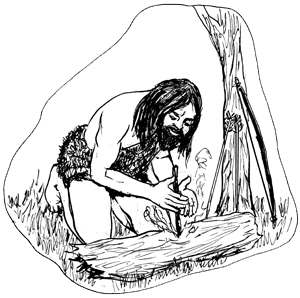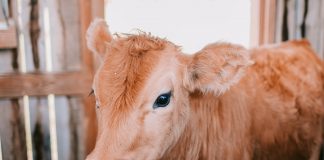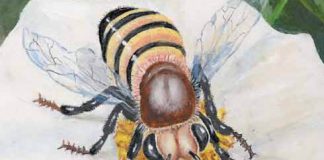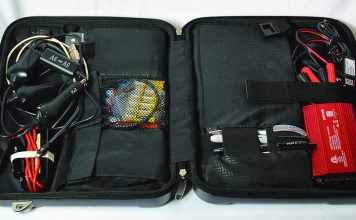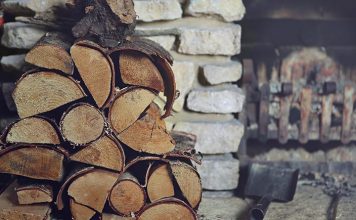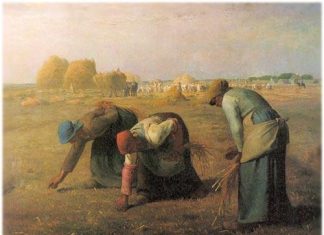| Issue #154 • July/August, 2015 |
There was a time when it was thought that a defining difference between humans and animals was: we use tools, they don’t. But, in the last few decades, it’s been discovered that many animals are tool users.
Before we go further, let’s define the word “tool” as I’m going to use it: It’s any object, other than a part of its body, that an animal uses to manipulate its environment. So, I’m not going to call its claws, mouth, tail, or any other organ on its body a tool. But if it uses a stick, a rock, fire, or builds a dam to manipulate its environment, I’m going to call those things tools.

Most of the time, animals that use tools make do with what they find. They don’t modify them. They may pick the best rock or stick to do the job, but only a few animals ever modify those tools to change their size, make them sharper, or easier to hold.
There are also at least two kinds of tool behavior. There’s genetic tool behavior and there’s acquired tool behavior.
Genetic tool use
Some tool use is genetically programmed behavior. Like other spiders, bolas spiders produce silk, but instead of using it to make webs, they fashion it into sticky balls that they throw at moths to ensnare them and reel them in. The blanket octopus tears poisonous tentacles from the Portuguese man-of-war jellyfish to use as weapons when attacked. And beavers scientists have raised away from other beavers, so they have never seen another beaver build a dam, will build dams anyway.
Nongenetic tool use
However, there are also many animals that use tools and there’s no evidence that their behavior is genetic. They either did some original problem solving or they watched another animal’s behavior and learned from it. For example, elephants know to drop logs across electric fences so they can cross them. Did one figure it out and did the others learn from observing? We don’t know. They also fashion branches into flyswatters, of just the right length, to swat pesky flies. They have even learned to use chewed bark to plug up private water holes in the dry season so that other animals can’t drain them. Bottlenose dolphins use sponges to stir up the sea bottom when hunting flounder and other bottom dwellers that hide in the sand. At least one zoologist claims only humans spend more time hunting with tools than these dolphins do.
Primates and tools
There are numerous other examples of animals that use tools, but it’s primates that show the greatest propensity for tool use among mammals.
Troops of chimpanzees are known to throw sticks and stones to intimidate other bands of chimps they encounter. More importantly, they use stones as hammers to crack nuts. Where did they learn to do this? I don’t know, but there is paleontological evidence that it’s been going on for thousands of years.
They will also make weapons. There are chimps in Senegal that make spears to injure and often kill bush babies, which they eat. They don’t just find a sharp stick, but will take a branch from a tree, strip off the leaves and smaller branches, and often fashion a point at one end with their teeth. Consciously modifying an object to create a better tool, as these chimps are doing, is a quantum leap in the animal world. But spears are not the only tools they fashion. They also make “tool kits” of variously shaped and sized sticks to hunt for army ants. They may be the only animal besides humans that make tool kits.
Interestingly, a chimp at a zoo in Sweden throws rocks at zoo visitors when it’s in a bad mood. That may not sound like much, but it stockpiles rocks and stashes them, evidence it’s accumulating them for future use. Though other animals, such as squirrels, might store food, storing tools, in this case weapons, is another behavior almost never found among animals. It’s what the chimps’ closest relatives humans also do.
But chimps aren’t the only tool users among the primates. (Yes, we’re primates, too, but I’m going to deal with us separately.) Captive orangutans use sticks to poke through the wires of a cage to acquire things beyond their reach and, if the stick is too short, they will go look for a longer one. In other words, they not only understand the concept of a tool but will find a better tool if the first one, two, or three don’t work. They are also capable of passing learned knowledge on to other orangutans. For example, they make whistles out of leaves to scare off predators, and one orangutan will teach another the skill. Passing on tool use is another trait rarely found among animals.
Last one I’ll mention is that gorillas use sticks to gauge the depth of water before attempting to cross it. The overwhelming majority of animals do not seem to be able to grasp the concept of using a tool as a measuring device. In fact, once again, it’s a very “human” trait.
Bird brains

When we think of animal intelligence, we usually think of mammals. However, New Caledonian crows use tools to solve a wider range of problems than almost any mammal. Like chimps, this bird can take things it finds in its environment and modify them to procure food. If brain size indicates intelligence, their brain-to-body mass ratio is the same as that of great apes, whales, dolphins, and porpoises. Only humans have larger brains in proportion to their body mass.
Crows and some of their relatives, including ravens, jays, and magpies (there are more than 120 species in the crow family), even seem to understand some basic concepts in physics. In controlled tests, they have been confronted with the problem of getting food floating in containers that are too small to fit their bills in. In a short time, they figure out that if they drop pebbles through the neck of the vessel, they can raise the water level until they can grab the food. This goes way beyond the comprehension of physics in any other animals other than man. They will also modify tools. Given lengths of wire and seemingly inaccessible food, they will quickly bend the wire to form a hook, if that’s what it takes to get what they want.
The fact that some birds are incredibly good at solving novel problems using tools, and the fact that birds are the last of the dinosaurs (modern zoologists regard them as avian dinosaurs), tells us that dinosaurs may have been much more intelligent than we previously thought.
What makes humans different?
Humans are the quintessential tool users. There are at least three important differences between tool use by humans and tool use by animals.
1. Unless more evidence comes in, humans are the only animals to kill members of their own species with tools. Although chimpanzees use spears to hunt, they don’t use them against each other and though they hurl sticks and stones at other troops it’s apparently only for intimidation.
2. While some animals use a few tools, humans use an immense variety of them, and apparently did so in prehistoric times. The breadth and frequency of our tool use and the frequency with which we modify objects to use them as tools is probably greater than that of all other animals combined.
3. Until contrary evidence emerges that says differently, the most important thing humans do with tools, and it seems to lie beyond the understanding of other animals, is that we use tools to make other tools. It may not sound like much, but it’s the very basis of civilization and it is a mental leap we haven’t seen in other animals. Without our tools-to-make-other-tools brain, the most basic inventions of humanity would be impossible. Fire is a tool, but we had to invent tools to make fire at will. Clothes are a tool, and humans invented bone and ivory needles to make clothes fit well and had to make yet other tools to make the needles. Humans had to invent a whole array of tools just to make “simple” bows and arrows. Writing is a tool that was invented by, of all people, accountants in the Middle East. But first clay had to be made to make surfaces on which to write. Later, paper, pens, etc. The scope and complexity of tool use comes so readily to us, but it has mind-boggling consequences. It made us the dominant life form on this planet.
When did it start?
Tool use by the earliest of our ancestors goes back at least 3.3 million years, to the australopithecines, one of the ancestors of the genus Homo, the genus to which modern humans belong. How our brains evolved to solve these problems is part of an ongoing debate among scientists. Many believe that for our brain to evolve into a tool-using brain, our hands had to evolve with it. Without our tool-using brain, our hands would not have evolved to have their unique tool-using grip, and without these human hands, our brains would not have had any reason to evolve to manipulate tools.
Extraterrestrials
No other animal on this planet uses tools the way humans do. In particular, none use them to make other tools a cornerstone of civilization.
The Search for Extraterrestrial Intelligence, has been scouring the skies for decades hoping to intercept messages from other civilizations that may exist in our galaxy. If they ever find one, the senders may resemble “one-eyed, one-horned, flyin’ purple people eaters,” but a trait they will have to have in common with humans is that they, too, will have to use tools to make other tools. Otherwise, we’re never going to hear from them.


